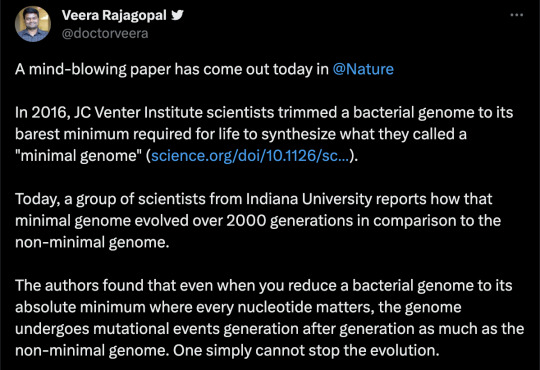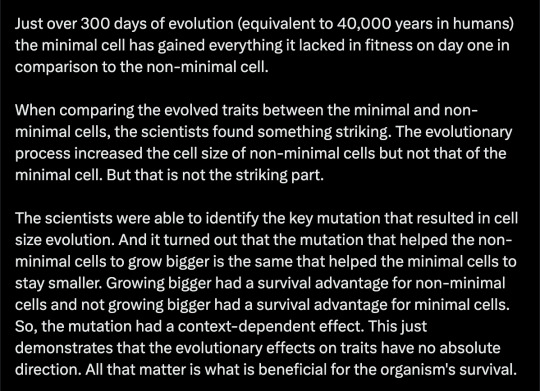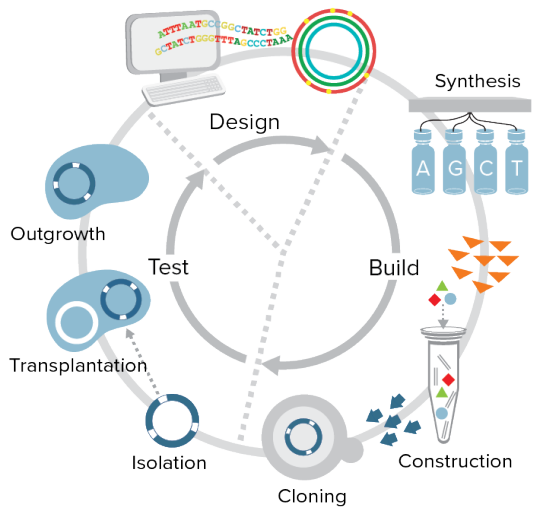#Craig Venter
Text





Published: Jul 5, 2023
“Listen, if there's one thing the history of evolution has taught us is that life will not be contained. Life breaks free. It expands to new territories, and it crashes through barriers painfully, maybe even dangerously, but . . . life finds a way,” said Ian Malcolm, Jeff Goldblum's character in Jurassic Park, the 1993 science fiction film about a park with living dinosaurs.
You won't find any Velociraptors lurking around evolutionary biologist Jay T. Lennon's lab; however, Lennon, a professor in the College of Arts and Sciences Department of Biology at Indiana University Bloomington, and his colleagues have found that life does indeed find a way. Lennon's research team has been studying a synthetically constructed minimal cell that has been stripped of all but its essential genes. The team found that the streamlined cell can evolve just as fast as a normal cell—demonstrating the capacity for organisms to adapt, even with an unnatural genome that would seemingly provide little flexibility.
“It appears there’s something about life that’s really robust,” says Lennon. “We can simplify it down to just the bare essentials, but that doesn’t stop evolution from going to work.”
For their study, Lennon’s team used the synthetic organism, Mycoplasma mycoides JCVI-syn3B—a minimized version of the bacterium M. mycoides commonly found in the guts of goats and similar animals.
Over millennia, the parasitic bacterium has naturally lost many of its genes as it evolved to depend on its host for nutrition. Researchers at the J. Craig Venter Institute in California took this one step further. In 2016, they eliminated 45 percent of the 901 genes from the natural M. mycoides genome—reducing it to the smallest set of genes required for autonomous cellular life. At 493 genes, the minimal genome of M. mycoides JCVI-syn3B is the smallest of any known free-living organism. In comparison, many animal and plant genomes contain more than 20,000 genes.

In principle, the simplest organism would have no functional redundancies and possess only the minimum number of genes essential for life. Any mutation in such an organism could lethally disrupt one or more cellular functions, placing constraints on evolution. Organisms with streamlined genomes have fewer targets upon which positive selection can act, thus limiting opportunities for adaptation.
Although M. mycoides JCVI-syn3B could grow and divide in laboratory conditions, Lennon and colleagues wanted to know how a minimal cell would respond to the forces of evolution over time, particularly given the limited raw materials upon which natural selection could operate as well as the uncharacterized input of new mutations.
“Every single gene in its genome is essential,” says Lennon in reference to M. mycoides JCVI-syn3B. “One could hypothesize that there is no wiggle room for mutations, which could constrain its potential to evolve.”
The researchers established that M. mycoides JCVI-syn3B, in fact, has an exceptionally high mutation rate. They then grew it in the lab where it was allowed to evolve freely for 300 days, equivalent to 2000 bacterial generations or about 40,000 years of human evolution.
The next step was to set up experiments to determine how the minimal cells that had evolved for 300 days performed in comparison to the original, non-minimal M. mycoides as well as to a strain of minimal cells that hadn't evolved for 300 days. In the comparison tests, the researchers put equal amounts of the strains being assessed together in a test tube. The strain better suited to its environment became the more common strain.
They found that the non-minimal version of the bacterium easily outcompeted the unevolved minimal version. The minimal bacterium that had evolved for 300 days, however, did much better, effectively recovering all of the fitness that it had lost due to genome streamlining. The researchers identified the genes that changed the most during evolution. Some of these genes were involved in constructing the surface of the cell, while the functions of several others remain unknown.
Details about the study can be found in a paper recently featured in Nature. Roy Z. Moger-Reischer, a Ph.D. student in the Lennon lab at the time of the study, is first author on the paper.
Understanding how organisms with simplified genomes overcome evolutionary challenges has important implications for long-standing problems in biology—including the treatment of clinical pathogens, the persistence of host-associated endosymbionts, the refinement of engineered microorganisms, and the origin of life itself. The research done by Lennon and his team demonstrates the power of natural selection to rapidly optimize fitness in the simplest autonomous organism, with implications for the evolution of cellular complexity. In other words, it shows that life finds a way.
#evolution#science#minimal cells#minimal cell#evidence for evolution#biology#minimal genome#life finds a way#religion is a mental illness
22 notes
·
View notes
Quote
覚えていない人のために説明すると、暗黒時代に遡り、ヒトゲノムを解読する競争がありました。 主要な競争相手(最も裕福な企業)は Celera Genomics と Human Genome Project でした。 しばらくして、セレラ(クレイグ・ヴェンター率いる)はその行為を行ったと発表した。 しかし、セレラが実際に行ったのは、彼らが「ショットガン法」と呼ぶもので、あちこちで小さなサンプルを採取し、さまざまな統計的詐欺を使ってゲノムのモデルを構築するというものでした。 約5年後、大騒ぎした後、彼らはゲノム全体の配列を解いていなかったことを認めた。
参照: https://www.technologyreview.com/2007/09/04/223919/craig-venters-genome/
ヒト Y 染色体は完全に配列決定されました。 ハッカーニュース
2 notes
·
View notes
Text




IMAGENES Y DATOS INTERESANTES DEL DIA 20 DE MAYO DE 2024
Día Mundial de las Abejas, Día Mundial de la Metrología, Día Internacional de los Ensayos Clínicos, Día Internacional de la Enfermedad de Behçet, Día Internacional del Síndrome de Williams, Semana Mundial de las Naciones Unidas sobre la Seguridad Vial, Semana Internacional de la Educación Artística, Semana Mundial del Parto Respetado, Año Internacional de los Camélidos.
San Bernardino de Siena.
Tal día como hoy en el año 2010
En EEUU, la revista Science publica que el equipo dirigido por el científico y empresario Craig Venter (uno de los padres del genoma humano), ha logrado la creación de la primera célula sintética. Este logro puede tener resultados en la investigación de las bacterias relacionadas con los combustibles limpios, la absorción del dióxido de carbono de la atmósfera o la fabricación de vacunas. Ahora se piden regulaciones legales de una técnica poderosa y con muchas posibilidades pero a la vez impredecible, incluso peligrosa, ya que también podría causar problemas en el medio ambiente o convertirse finalmente en destructiva y temeraria arma biológica. (Hace 14 años)
1927
Despega de Long Island (Nueva York, EE.UU.) el "Espíritu de San Luis" pilotado por el americano Charles Lindbergh a sus mandos. 33 horas y media después y tras recorrer 5.800 km, aterrizará en París, covirtiéndose en el primer hombre que realiza un vuelo trasatlántico sin escalas. (Hace 97 años)
1902
Tomás Estrada se convierte en el primer presidente de la República de Cuba tras el traspaso de poderes por parte de Estados Unidos que ocupaba la isla desde 1898. (Hace 122 años)
1900
Con la presencia de 21 países y 1.077 deportistas, se inauguran en París las II Olimpiadas de la Era Moderna. Se clausurarán el 28 de octubre del mismo año. Quedarán un poco deslucidas por la Exposición Universal. (Hace 124 años)
1882
Para oponerse al derrocamiento del jedive Tewfik, buques de guerra británicos y franceses entran en el puerto de Alejandría (Egipto). Los egipcios se muestran indignados por la intromisión extrajera. (Hace 142 años)
1862
El Congreso de los Estados Unidos de América promulga una ley, Homestead Act, por la que todo cabeza de familia mayor de 21 años, tendrá la oportunidad de comprar a buen precio 160 acres en el oeste del país, a condición de explotar la tierra al menos durante los primeros 5 años. La toma de territorios se convertirá en una carrera entre los colonos. (Hace 162 años)
1801
España invade Portugal durante la llamada Guerra de las Naranjas, tres meses después de haberle declarado la guerra, en represalia por haberse negado a cerrar sus puertos al comercio inglés. La guerra concluirá el 6 de junio del año en curso con la firma en la ciudad de Badajoz de un tratado de paz. (Hace 223 años)
1588
Comienza a zarpar del puerto de Lisboa la Armada Invencible española, con 65 navíos de guerra y otra cantidad similar de buques auxiliares, más 19.000 soldados y 11.000 marinos y remeros. Su objetivo: atacar Inglaterra y derrocar a su enemiga la reina Isabel I. En julio se verá sorprendida por terribles tormentas que diezmarán la flota. (Hace 436 años)
1498
El explorador portugués Vasco de Gama, que ha zarpado de Lisboa en julio del año pasado, se convierte en el primer europeo en alcanzar la India por mar al llegar a Calicut, en la costa de Malabar, en busca de especias. Allí se encuentra con la hostilidad de los comerciantes musulmanes. Con este viaje inaugura la vía marítimo-comercial de la ruta de las especias, sin depender del paso por las tierras hostiles del Imperio Otomano o del Norte de África. Esto será esencial para la expansión colonial y mercantil del pequeño reino de Portugal, convirtiéndolo en potencia naval y comercial a lo largo del siglo XVI. (Hace 526 años)
1 note
·
View note
Text
Dr. J. Craig Venter and the Science of Anti-Aging

In the captivating landscape of scientific exploration, few figures stand as prominently as Dr. J. Craig Venter. A maverick biologist and genomics pioneer, Venter's name is synonymous with groundbreaking discoveries that have reshaped our understanding of life itself. But beyond his contributions to genomics, Dr. Venter has also ventured into the realm of anti-aging research, embarking on a quest to unravel the mysteries of aging and extend the human lifespan.
Picture this: a charismatic scientist with a twinkle in his eye and a relentless curiosity that knows no bounds. That's Dr. J. Craig Venter in a nutshell. Known for his unconventional approach and fearless pursuit of the unknown, Venter has spent decades pushing the boundaries of science and challenging conventional wisdom.
Born on October 14, 1946, in Salt Lake City, Utah, Venter's journey into the world of science began at a young age. With a keen interest in biology and a thirst for knowledge, he pursued a career in research, earning a Ph.D. in Physiology and Pharmacology from the University of California, San Diego.
It was during his time as a researcher at the National Institutes of Health (NIH) that Venter made his first major breakthrough. In the 1990s, he led the team that sequenced the human genome, a monumental achievement that revolutionized the field of genetics and paved the way for countless medical advancements.
But Venter's quest for discovery was far from over. In the early 2000s, he founded the J. Craig Venter Institute (JCVI), a nonprofit research organization dedicated to advancing the science of genomics. Armed with cutting-edge technology and an insatiable curiosity, Venter and his team set their sights on unraveling the secrets of aging.
The concept of anti-aging has long captivated the human imagination. From mythical fountains of youth to modern-day miracle creams, humanity has been obsessed with the idea of prolonging youth and staving off the ravages of time. But for Venter, anti-aging is not just a fantasy – it's a scientific challenge waiting to be conquered.
At the heart of Venter's approach to anti-aging lies the concept of genomics. By studying the genetic code that governs the aging process, Venter believes that we can unlock the secrets to extending lifespan and improving healthspan – the period of life spent in good health.
One of Venter's most ambitious projects in the realm of anti-aging is the Human Longevity, Inc. (HLI), a company he co-founded in 2014. HLI is dedicated to using genomics, big data analytics, and machine learning to unravel the complexities of aging and develop personalized anti-aging interventions.
But Venter's vision goes beyond simply prolonging life. He envisions a future where aging is not just delayed, but reversed – where age-related diseases are a thing of the past, and people can enjoy vibrant health well into old age.
Of course, the road to realizing this vision is fraught with challenges. Aging is a complex process influenced by a multitude of factors, from genetics and lifestyle to environmental exposures. But Venter is undeterred. Armed with cutting-edge technology and a team of top-notch researchers, he is determined to crack the code of aging once and for all.
One of the key insights driving Venter's anti-aging research is the concept of biological age. Unlike chronological age, which simply measures the number of years a person has lived, biological age takes into account the physiological changes that occur over time. By identifying biomarkers of aging and developing ways to reverse them, Venter hopes to turn back the clock and rejuvenate the body from within.
But Venter's quest for eternal youth is not without its critics. Some skeptics argue that anti-aging research is a fool's errand – a quixotic quest for immortality that will ultimately end in disappointment. Others worry about the ethical implications of extending human lifespan, raising concerns about overpopulation and resource depletion.
But for Venter, the potential benefits of anti-aging research far outweigh the risks. By extending healthy lifespan, we can not only improve quality of life for individuals but also alleviate the burden of age-related diseases on society as a whole. From reducing healthcare costs to boosting productivity, the benefits of a longer, healthier lifespan are clear.
So where does Dr. J. Craig Venter's journey into the world of anti-aging go from here? Only time will tell. But one thing is for certain: with his boundless curiosity, fearless spirit, and unwavering determination, Venter is poised to leave an indelible mark on the field of anti-aging research – and perhaps, one day, on the very fabric of human existence itself.
1 note
·
View note
Text
Videos: “Space to Ground” & other space habitat reports – Oct.16.2023
This week's selection of videos about space stations and living in space including NASA's latest Space to Ground report for the International Space Station:
https://youtu.be/RcbqCOFdmYU
** Spacewalkers will collect samples to see if microorganisms exist on space station - Animation - VideoFromSpace
Astronauts Loral O’Hara and Andy Mogensen will "collect samples for analysis to see whether microorganisms may exist on the exterior" on the the International Space Station, according to NASA.
The spacewalk was scheduled for Oct. 11, 2023 but will be rescheduled due to leak on the Nauka module. Full Story: https://www.space.com/international-s...
https://youtu.be/cBh3NPeqjL0
** NASA Astronaut Frank Rubio Talks with Media Following Record-Breaking Mission - Oct. 13, 2023 - NASA
NASA astronaut Frank Rubio, who returned to Earth on Sept. 27 after spending 371 days in space, discussed his historic mission in a news conference on October 13. Rubio broke the record for longest single spaceflight by an American astronaut during his mission aboard the International Space Station where he lived and worked to advance scientific knowledge and demonstrate new technologies for future human and robotic exploration missions as part of NASA’s Moon and Mars exploration approach, including lunar missions through NASA’s Artemis program.
https://youtu.be/Nw-OfkUWUTM
** NLRA 2024-1: In-Space Production Applications: Tissue Engineering and Biomanufacturing - ISS National Lab
This webinar - held on October 13, 2023 - provided information of interest to offerors for NLRA 2024-1: In-Space Production Applications: Tissue Engineering and Biomanufacturing. The webinar offered details regarding the scope of the NLRA as well as the timeline, processes, and procedures for submitting proposals.
https://youtu.be/2Mnf8drszsI
** CA NV AZ UT Oct 13, 2023 0820 PDT - ISS Above
This is a very special morning pass of the Space Station over SoCal - passing directly over NASA JPL - where many of the team who work on Mission To Psyche are based. Congratulations to the entire team for a successful launch (7:19AM PDT)!
This pass on Oct 12, 2023 8:20 a.m. PDT
NOTE: The pass features so many cities in the County of LA including LACity, and beyond - and then passes over NV / City Of Las Vegas across a corner of AZ and finishing over UT
SOURCE: NASA EHDC6 Live views of the Earth from the International Space Station
https://youtu.be/Iv_1m2ukQDE
** A couple of items regarding space settlement:
*** John Jossy on The Space Show - A recent audio interview with space settlement proponent John Jossy. See his blog at Space Settlement Progress. (A recent post addresses the question, Why settle space?)
https://thespaceshow.com/sites/default/files/shows/4103-BWB-2023-10-15.mp3
*** Protect & Expand the Domain of Life, with Rick Tumlinson - Space Renaissance
Called one of the world’s top space “visionaries” and most influential people in the space field, Rick helped coin the term “NewSpace,” and is credited with helping birth the new commercial space industry highlighted by Musk, Bezos and Branson. A leading writer, speaker, and six-time Congressional witness, Rick helped start the first mission to find water on the Moon, signed the first space commercial data purchase agreement, led the commercial takeover of the Russian Mir space station, signed the first private astronaut to fly to the space station, co-founded the Space Frontier Foundation, and was a founding board member of the X-Prize. In 2015 he won the World Technology Award, along with Craig Venter of the Human Genome project. He founded the SpaceFund venture capital company with 20 space companies in its portfolio and is a member of the US Space Force Doctrine Organization Group. Rick’s Space Revolution “radiopod” is on IHeart Radio Network’s iRoc Space Radio and most podcast sites. He hosts the New Worlds Conference and Space Cowboy Ball in Austin, and his non-profit EarthLight Foundation is working to save the Earth while expanding life into the cosmos. They recently initiated Permission to Dream, to raise funds for placing a telescope in every middle school on Earth that wants one, so that new generations can see the rings of Saturn and the mountains of the Moon.
https://www.youtube.com/live/3_Bu1H6oeI0
** Live Video from the International Space Station (Official NASA Stream) - NASA
Watch live video from the International Space Station, including inside views when the crew aboard the space station is on duty. Views of Earth are also streamed from an external camera located outside of the space station. During periods of signal loss due to handover between communications satellites, a blue screen is displayed.
The space station orbits Earth about 250 miles (425 kilometers) above the surface. An international partnership of five space agencies from 15 countries operates the station, and it has been continuously occupied since November 2000. It's a microgravity laboratory where science, research, and human innovation make way for new technologies and research breakthroughs not possible on Earth. More: https://go.nasa.gov/3CkVtC8
Did you know you can spot the station without a telescope? It looks like a fast-moving star, but you have to know when to look up. Sign up for text messages or email alerts to let you know when (and where) to spot the station and wave to the crew: https://spotthestation.nasa.gov
https://www.youtube.com/live/xAieE-QtOeM?feature=share
====

ISS after undocking of STS-132
=== Amazon Ads ===
Lego Ideas International Space Station
21321 Toy Blocks, Present, Space, Boys, Girls, Ages 16 and Up
====
Outpost in Orbit:
A Pictorial & Verbal History of the Space Station
Read the full article
0 notes
Link
Tal día como hoy, en 1946, nace Craig Venter, biólogo, empresario y uno de los mayores emprendedores privados de la ciencia. En el año 2000, su empresa “Celera Genomics” secuenció el genoma humano.
https://buff.ly/3Qh4UsL:
0 notes
Quote
Researchers from the J. Craig Venter Institute (JCVI) and Synthetic Genomics, Inc. (SGI) have accomplished the next feat in synthetic biology research—the design and construction of the first minimal synthetic bacterial cell, JCVI-syn3.0.
Using the first synthetic cell, Mycoplasma mycoides JCVI-syn1.0 (built by this same team in 2010), JCVI-syn3.0 was developed through a design, build, and test (DBT) process using genes from JCVI-syn1.0. The new minimal synthetic cell contains only 531,000 base pairs and just 473 genes making it the smallest genome of any self-replicating organism.
First Minimal Synthetic Bacterial Cell | J. Craig Venter Institute
0 notes
Text
Personalized Genomics in Healthcare

The first individuals to ever have their genomes sequenced were James Watson, the co-discoverer of the DNA double helix structure, and Craig Venter, the founder of Celera Genomics. Even Steve Jobs paid $100,000 to have his DNA sequenced in 2011 when his pancreatic cancer relapsed, in hopes that his genetic data would help him find treatments better suited to treat his unique cancer pathology in the context of his own unique genetic makeup. Unfortunately, cancer treatment and personalized genomics at the time were not nearly as advanced as they are today. Unprecedented strides in the field of genomics have provided individuals the opportunity to sequence their entire genome or parts of it with the goal of understanding their potential health risks, living a lifestyle catered to avoid them, and being better prepared mentally and physically to deal with them if they arise. Not to mention, it costs much less to have your entire genome sequenced now than it did a decade ago.
.
.
Read more
.
.
For more information
0 notes
Text
https://odysee.com/@TheDTrain:a/Craig-Venter-Unveils-Synthetic-Life-Final:e
👹👹👹
0 notes
Text
Tidjane Thiam’s Spac in merger talks with life sciences group Human Longevity
Tidjane Thiam’s Spac in merger talks with life sciences group Human Longevity
Tidjane Thiam’s blank-cheque company is in advanced talks to merge with a Californian life sciences group founded by genomics pioneer Craig Venter, which offers clients a battery of expensive tests to try to prolong their lives.
The former Credit Suisse chief executive plans to use his $345mn special purpose acquisition company, Freedom Acquisition Corp, to merge with Human Longevity Inc for an…

View On WordPress
0 notes
Link
Tal día como hoy, en 1946, nace Craig Venter, la única persona no anónima de la que se conoce su genoma completo. Lo secuenció él mismo https://buff.ly/3eCG9ap:
0 notes
Text
Venture-backed Celularity receives FDA approval for early trials of a new cell therapy for COVID-19
Celularity, the venture-backed developer of novel cell therapies for cancer treatments, has received an initial clearance from the Food and Drug Administration to begin early-stage clinical trials on a potential treatment for COVID-19.
The company, which has raised at least $290 million to date (according to Crunchbase), uses “Natural Killer” (NK) cell therapies to boost the immune system’s…
View On WordPress
#Cancer#China#COVID-19#Craig Venter#Disease#Food and Drug Administration#Genomics#human longevity#infection#medicine#stem cells#TC
0 notes
